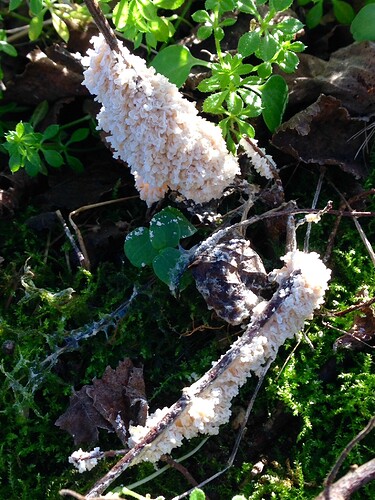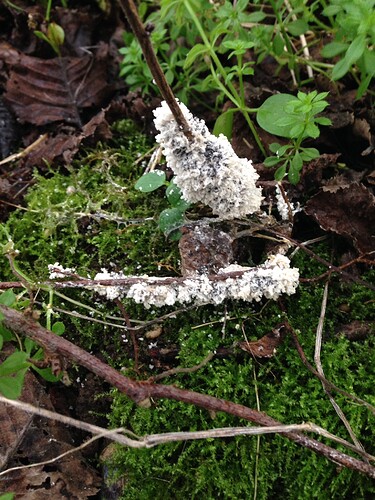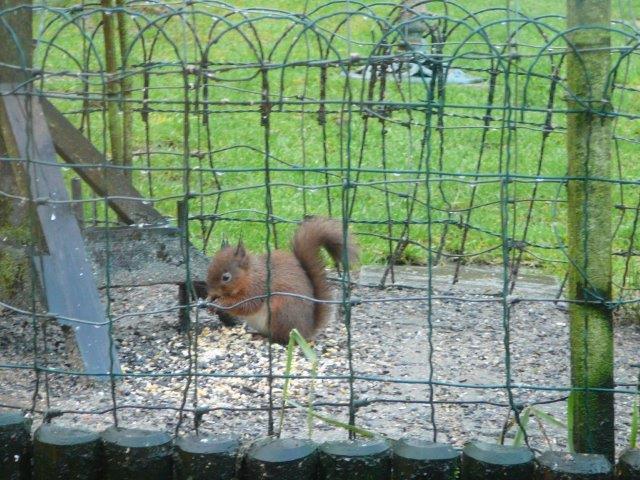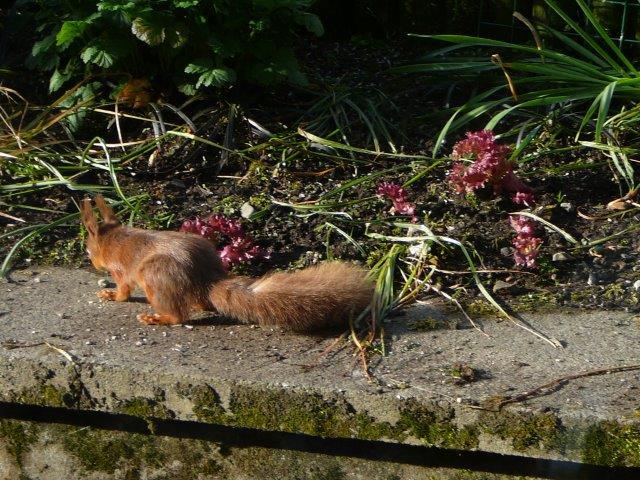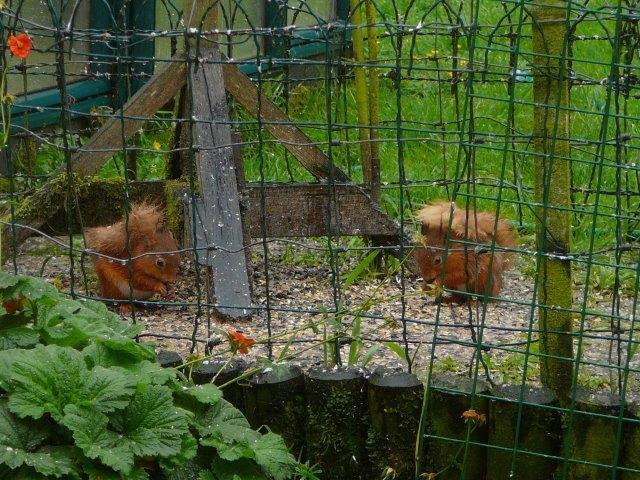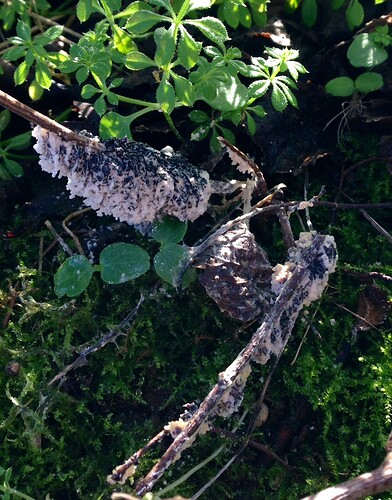I think you may have the photo o’r flwyddyn with that titws Tomos las. Arbennig o dda.
Agreed - gorgeous!
Your are all very kind - Dach chi gyd yn rhy carredig.
Just a lucky to be in the right place at the right time (i got a lot of rubbish photo’s as well).
I’m not sure about the species of fern, but it does look very like.
Marchredyn cyffredin. ffrond hyd at 1.25m.
Rhedynen sy’n ffurfio twmpathau mawr mewn coetiroedd ac ar gloddiau.
Mae’r ffrondiau’n wyrdd trwy’r gaeaf, ar y cyfan maent yn hirgrwn wedi’u rhannu, fel pluen ddwy waith â chen brown golau ar y coesyn.
Mae’r sborangiwm yn grwn, brown pan aeddfed, Awst – Hydref.
Male fern. Fronds up to 1.25 m long.
Fern forming large mounds in woodlands and hedgerows.
The ffrondiau’n green throughout the winter, for the most part they are oval, divided like a feather twice with light brown scales on the stem.
The sporangium round, brown when mature, August - October.
Modified description from Iolo Willams book.
Cheers J.P.
I grow ferns in my front garden because it faces north and gets a lot of rain. Unfortunately, although one of them looks like your picture, it is about 11 years since I planted them and I don’t recall any of the names!!!
I now do remember it was one organism that changed its ways, the slime mould, I mean, not the fern!
Also, I am truly sorry, but I cannot find grey squirrels charming. Out gwiwerod cochion, now, they are charming… I just wish the Forestry Commission hadn’t harvested their home trees and driven them out of range of our tasty treats!!!
Are grey squirrels the introduced ones, the ones that are threatening the native British squirrels?
Yes, and I was raised to see them as pests, but I haven’t retained unquestioning belief in anything else from childhood, so I don’t think that’s why I see grey ones as ‘tree rats’ and red ones as absolutely lovely, cheeky little creatures!!
My boyfriend also referred to the grey squirrels as to invaders and bullies, and to the red ones as to the adorable British squirrels:) It’s very sad that introduced fauna should be threatening the native animals(
One thing i forgot to mention about Ferns, is that they seem (along with a few other life forms) to be something of an anomaly given that they have very large genomes (many more genes than us), which is at odds with the idea that genome size is related to species complexity.
For the grey squirrel, i know just where you are coming from as i grew up with the same opinions around me, the problems caused in New Zealand by introduced species is way beyond sad.
Now the slime mold is certainly interesting and i’m hoping to meet with the fine lady posting the images so i can explain to her how to propagate them in a sandwich box.
An idea i’m sure she will leap at 
Just got in so need to check if there is anything useful on my camera.
Cheers J.P.
Tafod Yr hydd - Hart’s tongue fern.
Tafod yr hydd ffrond hyd at 60 cm.
Rhedynen fytholwyrdd coetiroedd llaith a chloddiau.
Eithaf cyffredin ledled prydain, fwyaf cyffredin yng nghorllewin Prydain ac Iwerddon.
Ffrondiau gwyrdd, ffres heb eu rhannu’n edrych fel strap, ac yn ffurfion clystyrau.
Rhesi o sborangia brown tywyll ar ochr isaf y ffrondiau.
Hart’s Tongue fern frond up to 60 cm long.
Evergreen fern damp woodlands and hedgerows.
Quite common throughout britain, most commonly in west Britain and Ireland.
Fronds green, fresh looking as un-split strap, and formed in clusters.
Sporangia rows of dark brown on the underside of the fronds.
cheers J.P.
Quite a difference today but it had survived the wind & rain. It seems to be turning black from the inside out.
After a stormy night the sky has cleared and calmed, so just maybe a little sunshine instead of rain to finish the year.
Lleuad bora hyn 311215 - the moon this morning.
With shadow half way across the moon it made me think of 2016 soon starting on the other side of the world (international date line). Enjoy your celebrations.
Cheers J.P.
And a happy new year to you too, JP! Love your photos.
John has said I can post the following, despite it being somewhat historic!! It will be very long and I may have to do it in installments. I apologise in advance if I bore anyone:
Y hanes gwiwerod
It was in December 2012 that I first stared through our kitchen window, entranced and hardly daring to move, lest I frighten away the latest visitor to our bird table. The picture was taken on January 1st 2013, by which time I had taken to calling him/her ‘Wiwer’ and knew he/she would not flee merely because of movement in the kitchen!
I soon noticed that poor Wiwer had a damaged tail. It seemed to have a line across it, like a scar. What follows is the best picture we got showing this. In the picture, Wiwer is on the retaining wall between the path and the garden and is about a metre from the back window!
That was among the last views I have. Late August 2013. By then I was fairly sure Wiwer is a male. Check my logic here… Wiwer came alone virtually every day from January to August 2013. Towards the end of that time, I started to see at least two other squirrels. One was small and fluffy, so I called that one, unoriginally, ‘Fflyffi’!! One was bigger and fluffy and …sorry folks, I called it ‘Fflyffi Fawr’, or ‘Big Fluffy’ in English. I think I also saw a less fluffy small one. The only picture we have of more than one is:
They look much the same size and you can’t tell if either is Wiwer, but I could never be sure how many we had in total. My theory is that Wiwer was ‘Dad’ as he came all the time. Mam will have had to look after the babies in the drey and would not have ventured all the way to our source of treats until the kids were old enough to come.
I have a couple more pictures, if you would like to see them. I think your all know that I never see them now, because the Forestry Commission harvested their trees. They have Wildlife Officers, so I am sure care was taken to ensure the squirrels were not hurt and were re-settled, but they never came here to us again!
If I don’t receive cries of pain and boredom, I’ll send the rest of the story in the New Year.
They’re adorable:) I’ll be waiting for the rest of the story! Blwyddyn newydd dda, @henddraig dear!, and thank you for the story and the lovely pictures!
Excellent photo’s and story Jackie.
I remember seeing them as a child in Norfolk from where they have long disappeared.
Then five years ago walking north i came upon some on the pennine way, that was a lucky day to remember.
Today outside with the Oxford group we happened upon fungus that have a bit of folklore attached, and i now find the same idea/name carried over into Welsh.
Peli duon (yn yr Cymraeg) , Daldinia concentrica (yn Latin).
In English they are know as King Alfred’s cakes (as he was to busy thinking of other things and forgot to check the cakes in the oven, so they burnt into brown/black lumps like in the photo.
I find the alternative name in Cymraeg ydi, Cacenni y Brenin Alfred.
In the lower image, i hope people can see the concentric growth rings as this species expands, (hence the Latin name (they tend to be descriptive)), the neat part not obvious in the photo is if a broken half is wobbled in the sunlight the broken fungus surface shimmers and glistens reflecting the light at many angles.
Cheers J.P.
I’ll be looking forward to it.
Another day, & the slime mould is a bit different again.
Such a good day today ffwng spotting with @johnwilliams_6 & @ramblingjohn
Have since revised:
Ysguthan = wood pigeon
Carw = deer
Cawr = giant
Titw’r Wern = Marsh tit
Ystlys = flank
Ystlum = bat (the mammal)
Happy New Year!
Damn! That’s another tit I don’t think I’ve seen. There is plenty of bog/marsh round here. Anyone got a good picture of a marsh tit?
I’m afraid that is a difficult/uncertain question.
The old books give physical differences that seem now to have been found unreliable.
The latest opinions i can find, say the song/call is the most reliable difference and
having listened to several recordings i concluded those i post are willow tits (from the call),
but i wouldn’t argue with anyone who said i was wrong.
I know some fungi which were two species are now one due to DNA comparison.
Cheers J.P.
